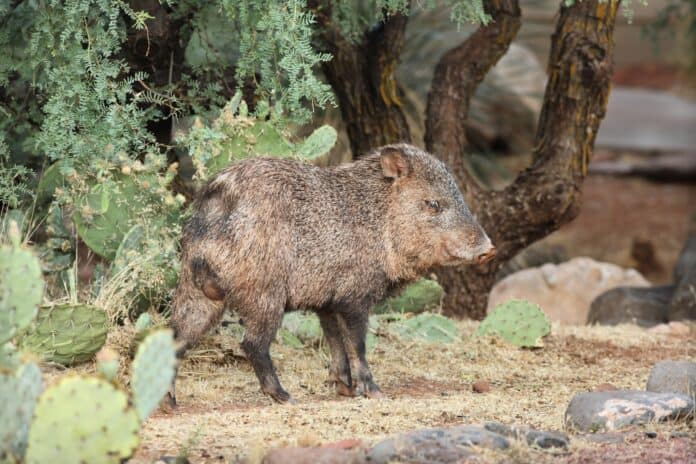
Feeding wildlife in Sedona will be prohibited as of Thursday, May 11, after the Sedona City Council approved a ban on the practice at its April 11 meeting.
Representatives from the Arizona Game and Fish Department and the Sierra Club welcomed the ban, which comes at a time of year when AZGFD historically receives the most calls about human-wildlife interactions as the Sonoran Desert starts getting drier and wildlife is on the move.
“We can’t underscore enough the dangers of feeding wildlife,” Mark Hart of AZGFD said. “It’s just bad practice. We want people to enjoy wildlife from a distance. Any time you’re getting too close, or getting them to persist in the community, the hazards go up considerably.”
Hart also claimed that at least one javelina bite occurs every three months in Tucson, a city with a population of 542,000.
The ordinance provides that first offenders will receive a written warning and be given unspecified educational materials. A second violation within 90 days will carry a fine of up to $150. Additional offenses will carry fines of up to $500.
Hart claimed that feeding human food to wildlife is unhealthy for animals and dangerous for people. Wildlife feeding is currently illegal in Pima, Pinal, and Maricopa counties under state law, and some counties have their own ordinances.
In the unincorporated areas of Cochise County, fines for feeding wildlife can be as much as $1,500, compared to $300 under state law.
“The ordinance states that it is unlawful for any person within the city limits to intentionally, knowingly or recklessly feed wildlife or to attract wildlife, including bears, javelina, deer, elk, coyotes, skunks, foxes, bobcats and/or mountain lions. This ordinance is not applicable to birds,
The ordinance was drafted in response to two incidents in Uptown and one in West Sedona last year when residents were bitten by javelina, which occurred because the animals were attracted to food and the individuals were in close proximity.
“As a result of the repeated wildlife bites in the neighborhood, AZGFD relocated a group of 19 javelina in December,” city documents state. “Despite this effort, the neighborhood continues to experience ongoing issues with javelina.”
The leading cause of javelina bites to humans in Arizona is feeding, Hart said.
“The second leading cause of javelina bites in Arizona is adverse interactions with dogs,” Hart added. “Javelina cannot distinguish your dog from a coyote, their natural predator. They don’t see very well, but they smell keenly and react instinctively to the presence of dogs. If you’re feeding wildlife, knowingly or unknowingly it can end up affecting dog owners.”
Feeding other species of wildlife like deer can also draw predators such as mountain lions and even black bears, which are attracted to things like garbage cans put out before the day of pickup or fruit falling from trees and bird feeders, whether they have seeds or nectar. AZGFD wants to deter Arizonans from having anything that attracts larger animals and encourages them to stay in one neighborhood.
A provision in the Sedona ordinance does allow the responsible use of bird feeders provided that they are at least four feet above the ground or secured in a way that makes them inaccessible to other wildlife.
The ordinance also permits “normal agricultural or livestock operational practices or any person feeding their own domestic animals … water features such as fountains, ponds, birdbaths or similar structures where the primary purpose is ornamental … growing plants or … fruit-bearing trees and the parts of those plants that may have fallen to the ground … compost piles that are … made inaccessible to wildlife … and hand feeding of ducks or waterfowl on lakes.”
Jack-o’-lanterns left out at Halloween will not be a violation of the ordinance, city communications manager Lauren Browne stated in an email.
“The intent of the ordinance isn’t to target residents during Halloween who understandably leave pumpkins out around the holiday, but is for people who are intentionally feeding wildlife through methods like feeders, bowls of food left out,” Browne wrote.
However, there is no stated exception for pumpkins or Jack-o’-lanterns in the ordinance.
Browne also said that code enforcers and police will enforce the ordinance uniformly.
Hart said that feeding animals can be hazardous to them as well as to humans.
“[In] Tucson we suspect that 10 javelina died a few years back from eating rotten produce,” Hart said. “The scenario goes like this. You’ve got produce in your refrigerator, it’s starting to go bad. You don’t want to waste it. So you throw it over your fence line for the wildlife to eat. But, if it’s not good for you to eat, it’s not good for the wildlife to eat.”
Eating processed food can have significant effects on animal as well as human behavior. A 2016 study in the journal “Scientific Reports” found that bears in Colorado that eat large amounts of human food hibernate as much as 50 days less each winter.


















